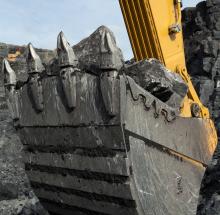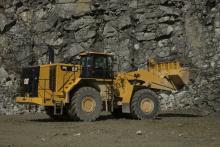
A wheeled loader is a crucial piece of equipment on any quarry site, and specifying the right unit for the right job is of primary significance, writes Munesu Shoko.
For speedy and economic execution of loading duties, proper choice of equipment is of primary importance. When selecting the most efficient wheeled loader for the job at hand, the key is to hit desired production goals for the lowest total cost of ownership. But, how best is this achievable?
Todd Tuntland, product application specialist – large wheeled loaders at
Frank Schmitt, GPPE wheeled loader product manager at
“Factors such as machine availability (uptime), fuel efficiency and productivity will have a big influence on your cost per tonne as well,” he says.
Dominik Brandauer, area sales manager at
Stephen McNeill, product marketing manager at
Miguel Angel Torres, business director at
Job conditions play a big role in the choice of a wheeled loader. Andrew Boyers, business development manager – Africa at
Schmitt says if the wheeled loader doesn’t match the application, it is difficult to reach the required production targets, or you may not even be able to get the job done at all. “If the machine size doesn’t match the application, you have the risk of destroying the unit or reducing the lifetime of the wheel loader significantly,” he says. “Volvo provides special application packages as ready-to-select options, making a Volvo machine perfectly ideal for specific applications, such as waste handling, block handling, rock and quarry handling, among others.”
According to Brandauer, job conditions are very important for the choice of the right wheeled loader, because they inform several other decisions such as tyre choice, dumping height, angle of articulation, maximum height and bucket width, to mention a few. “If you know your working conditions you can also calculate service intervals or even spare parts you need for a particular project,” says Brandauer.
Torres shares the same view with Brandauer, saying a good understanding of the job conditions is key to specifying the right machine to achieve the best results. He adds that underfoot conditions largely determine tyre choice, which is another significant element of ownership costs, as well as the configuration of the axle components to match either hard standing surfaces or very challenging, muddy or slippery conditions.
Not sizing the machine to meet production targets is a frequent gaffe on many sites. How best can one determine the ideal size of the wheeled loader they need on site? According to Torres, a good understanding of job conditions includes the assessment of desired productivity, material densities, working hours, type of ground, dump heights and ramps, among other things. “It gives you the needed info for a proper machine sizing, which always starts with the key metric of a wheel loader: its payload. A proper payload choice guarantees the desired productivity and optimised costs,” says Torres.
McNeill says to know the right-sized machine, one needs to calculate what size of wheeled loader is going to deliver the most productivity with the least idling time for a particular operation. But, how best do you get this right? Brandauer says a number of factors need to be considered. These include required capacity per day/shift/month; material filling factor of the bucket; loading cycle (distance/time); working hours per day/shift/month; idle time/breaks per day/shift/month; material density; and average speed of the wheeled loader. “With these figures you can calculate the right size of the bucket, which in turn allows you to choose the right-sized wheel loader,” says Brandauer.
According to Tuntland, one of the most effective ways of sizing a wheeled loader or any loading tool is through a site assessment. “Caterpillar and its dealers are equipped with system application specialists who can perform this assessment. For existing sites, it is very important to measure the ‘as is’ production capabilities. This is done by capturing various parameters from the site: cycle times, payloads, fuel burn, production per hour, haul road profiles, among others,” he says. “Once this is complete, data can be compared with production targets.” Additionally Caterpillar has the capability to run “to be” scenarios in its own software tool by changing parameters: loading tools, hauling units and even haul roads.
Schmitt believes sizing the machine is very important. He says there is a need to consider the conditions on site. “For sure, the productivity requirements for bucket size and cycle time play a major role. However, you also need to consider matching the equipment to avoid any losses in the production process, for example, due to a long loading time or idling of the hauling units in the supply chain,” he says. Schmitt adds that the most common reason for high costs per tonne are oversized machines versus the required production output. Oversized machines have a higher initial purchase price, higher running costs and usually also higher idling times.
Meanwhile, fuel efficiency is always one of the key parameters when choosing any piece of equipment for the job at hand. While fuel efficiency is achieved through a number of initiatives, the choice of a wheeled loader’s driveline plays a bigger role in the overall efficiency. “The choice of the driveline is very important for fuel efficiency. With Liebherr’s hydrostatic driveline you need less rpm to get the same output on torque as on a wheel loader with a torque converter. Less rpm means less fuel consumption,” says Brandauer.
McNeill says hydrostatically-driven machines are generally deemed to provide better fuel efficiency advantages, but the customer pays for this through the higher capital cost, as well as repair and maintenance costs associated with the machines. “Bell wheel loaders are direct drive vehicles with an automatic transmission and torque converter. They deliver similar fuel efficiency, because it is not only the drive that impacts this, but are less complex and less costly to maintain, while being suited to all applications,” says McNeill.
According to Tuntland, overall configuration is very important when it comes to efficiency. Just to name a few: ride control, axle oil cooler, standard lift or high lift, bucket, tyres, all have a significant impact on fuel efficiency, he says. “As you can imagine, anything that slows down production will in turn decrease efficiency. Factors such as ride quality, reach, dump clearance and stability, can all have an impact on production. It’s very important that the machine is configured correctly for the application,” he says.
Torres is of the view that the driveline is key, and there are many factors related to it that affect the overall machine efficiency and uptime. “Payload is the key metric that dictates the value of a wheel loader. CASE wheel loaders have perfected the art of reducing deadweight, optimising payload versus weight. This translates into outstanding fuel efficiency and reduced maintenance costs,” says Torres.
Bucket selection also has a major impact on overall loading efficiency. According to Brandauer, several factors such as penetration of the material, length of the bucket floor, material of the bucket, filling factor, weight of the bucket or breakout performance, are very important when choosing the right bucket.
Torres says understanding material density and the composition of the material are important for bucket selection. Dense, wet or heavy material has a very different characteristic to dry, loose and light material.Therefore, knowing the material to be handled will assist in specifying the correct bucket for material volume. “Both the material to be handled and its characteristics will also help determine bucket composition in terms of the need for heavy duty, strengthened buckets used when handling very dense and/or abrasive material or larger buckets used for applications such as coal handling,” says Torres.
Schmitt agrees, saying that the two major factors are the material to be loaded, for example, abrasive, blasted rocks from the face and loose material, among others, as well as the required dump height, for example, the side wall height of the truck or the height of a feeding hopper. “How easy or difficult it is to penetrate the material influences the bucket design and ground engaging tools, while the material density influences the bucket volume for the different machine sizes,” says Schmitt.
According to Tuntland, key considerations when it comes to bucket selection include material density, abrasiveness, fragmentation, bucket fill factor, as well as pass match target.
Caterpillar offers a broad range of bucket sizes to accommodate densities that allow its customers to hit target payload. “We also provide additional wear packages to handle abrasive materials. The key is selecting a bucket that will meet production requirements while still providing adequate life; it’s all about finding the right balance,” says Tuntland.
Dave Worth, engineering project leader, Work Tools at Caterpillar, adds that the key considerations when it comes to bucket selection are operation type, material fragmentation, material type, material density, impact and abrasion properties. “These factors enable the correct bucket choice to maximise loader performance and efficiency, while minimising machine downtime and operating costs,” says Worth.







